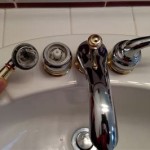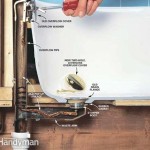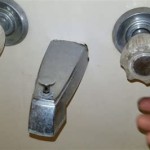What's the Best Thing to Clean a Bathtub With?
Maintaining a clean bathtub is crucial for hygiene and aesthetics. A dirty bathtub can harbor bacteria, mold, and mildew, posing potential health risks. Additionally, soap scum, hard water stains, and other residue build-up can make the bathtub look unsightly and diminish the overall appeal of the bathroom. Determining the "best" cleaning agent depends on various factors, including the type of bathtub material, the severity of the staining, and personal preferences concerning harsh chemicals and environmental impact. This article examines various cleaning options for bathtubs, analyzes their effectiveness, and discusses their potential drawbacks to facilitate informed decision-making.
Bathtubs are generally constructed from various materials, each requiring specific care and cleaning methods. Acrylic, fiberglass, porcelain-enameled steel, and cast iron are among the most common. Acrylic and fiberglass are relatively lightweight and susceptible to scratches. Porcelain-enameled steel and cast iron are more durable but can chip and rust. Understanding the bathtub material is paramount when selecting a cleaning agent to avoid damaging the surface.
Evaluating Common Cleaning Agents: Commercial Options
The market offers a wide array of commercially available bathtub cleaners, each formulated with specific chemical compositions designed to tackle different types of stains and grime. These cleaners often contain surfactants, which reduce surface tension and help loosen dirt and grease; solvents, which dissolve oily residues; and abrasives, which physically scrub away stubborn stains. The choice of commercial cleaner depends largely on the type of stain and the user's tolerance for strong chemical odors and potential environmental impact. Some popular commercial options include:
1. Spray-On Bathtub Cleaners: These cleaners are typically designed for regular maintenance and are effective at removing light soap scum and grime. They often contain bleach or other disinfectants, providing an added layer of sanitization. However, prolonged exposure to bleach can weaken the grout and discolor certain bathtub materials. Furthermore, the strong fumes can be irritating to some individuals, requiring adequate ventilation during use.
2. Abrasive Cleansers: Powdered or liquid abrasive cleansers contain fine particles that physically scrub away stains and residue. These are particularly effective for tackling stubborn hard water stains and rust marks. However, abrasive cleansers can scratch delicate surfaces like acrylic and fiberglass, leading to a dull or damaged finish. When using abrasive cleansers, it is crucial to test them on an inconspicuous area first to assess their potential for damage.
3. Acidic Cleaners: Cleaners containing acids, such as hydrochloric acid or phosphoric acid, are powerful stain removers, particularly effective against mineral deposits and rust. However, these cleaners are highly corrosive and can damage the bathtub surface, grout, and surrounding fixtures if not used with extreme caution. They also pose a significant health risk if inhaled or ingested, requiring the use of protective gear like gloves and masks.
4. Enzyme-Based Cleaners: These cleaners utilize enzymes to break down organic matter, such as soap scum and body oils. They are generally considered safer and more environmentally friendly than cleaners containing harsh chemicals. However, enzyme-based cleaners may require longer dwell times to be effective and may not be as potent against stubborn stains.
Exploring Natural Cleaning Alternatives
For individuals seeking environmentally friendly and less harsh alternatives, several natural cleaning agents can be effective for cleaning bathtubs. These options often utilize readily available household ingredients and minimize the risk of exposure to harmful chemicals. While they may require more effort and longer dwell times than commercial cleaners, they offer a safer and more sustainable cleaning solution.
1. Baking Soda: Baking soda is a mild abrasive that can effectively remove soap scum and deodorize the bathtub. It can be used alone as a scrubbing agent or mixed with water to create a paste. For tougher stains, baking soda can be combined with vinegar to create a fizzing action that helps loosen grime. However, the resulting concoction should be used cautiously on delicate surfaces to avoid potential scratching.
2. Vinegar: Vinegar, particularly white vinegar, is a natural acid that can dissolve mineral deposits and remove mildew. It can be sprayed directly onto the bathtub surface or mixed with water for a less concentrated solution. Vinegar is particularly effective at removing hard water stains and can be used to clean showerheads and faucets as well. The strong odor of vinegar can be mitigated by adding a few drops of essential oils, such as lemon or lavender.
3. Borax: Borax, also known as sodium borate, is a natural mineral with cleaning and disinfecting properties. It can be used to remove stains, kill mold and mildew, and deodorize the bathtub. Borax is generally considered safe, but it should be handled with care to avoid eye and skin irritation. It is essential to keep borax out of reach of children and pets.
4. Lemon Juice: Lemon juice is another natural acid that can be used to clean bathtubs. It is particularly effective at removing soap scum and brightening the bathtub surface. Lemon juice can be applied directly to stains or mixed with water for a less concentrated solution. The citric acid in lemon juice also has antibacterial properties, providing an added layer of sanitization.
Key Considerations for Bathtub Cleaning
Regardless of the chosen cleaning agent, several key considerations are crucial for effective and safe bathtub cleaning. These include proper ventilation, appropriate dwell times, and the use of suitable cleaning tools. Neglecting these factors can lead to ineffective cleaning, potential damage to the bathtub surface, and health risks.
1. Ventilation: Adequate ventilation is essential when using any cleaning agent, particularly those containing strong chemicals or fumes. Opening windows and turning on the exhaust fan can help to dissipate fumes and prevent respiratory irritation. Inadequate ventilation can lead to the build-up of harmful vapors, posing a significant health risk.
2. Dwell Time: Allowing the cleaning agent to dwell on the surface for the recommended time is crucial for its effectiveness. Dwell time allows the cleaning agent to penetrate the stain and loosen the grime. However, exceeding the recommended dwell time can potentially damage the bathtub surface, particularly when using acidic or abrasive cleaners. Always follow the manufacturer's instructions regarding dwell time.
3. Cleaning Tools: The choice of cleaning tools can significantly impact the effectiveness of bathtub cleaning. Soft sponges and cloths are suitable for general cleaning and preventing scratches. Stiffer brushes can be used for tackling stubborn stains, but they should be used with caution on delicate surfaces. Avoid using abrasive scrub pads or steel wool, as they can scratch and damage the bathtub surface. Grout brushes are essential for cleaning grout lines, which are prone to mold and mildew growth.
4. Pre-Cleaning Preparation: Before applying any cleaning agent, it is essential to rinse the bathtub thoroughly with water to remove loose debris and dirt. This step helps to prevent the cleaning agent from becoming diluted and ensures that it can effectively target the stains and grime. Removing excess water after applying the cleaner, but before the dwell time, can also prevent dilution.
5. Testing in an Inconspicuous Area: Regardless of the type of cleaning agent used, it is always advisable to test it in an inconspicuous area of the bathtub before applying it to the entire surface. This step helps to assess the potential for damage or discoloration. Allow the cleaning agent to dwell on the test area for the recommended time, then rinse and inspect the surface for any adverse effects.
6. Rinsing Thoroughly: After the cleaning agent has dwelled on the surface for the recommended time, it is essential to rinse the bathtub thoroughly with water to remove any residue. Residual cleaning agents can potentially damage the bathtub surface over time and may also pose a health risk to individuals using the bathtub. Ensure that all traces of the cleaning agent are removed, particularly from grout lines and corners.
7. Drying the Bathtub: After rinsing the bathtub, drying it with a clean cloth can help to prevent water spots and mildew growth. This step is particularly important in areas with high humidity. A dry bathtub is less likely to harbor bacteria and mold, contributing to a cleaner and more hygienic bathroom environment.
Ultimately, the "best" thing to clean a bathtub with depends on individual needs and priorities. Understanding the characteristics of different cleaning agents, considering the bathtub material, and following proper cleaning procedures are essential for maintaining a clean and hygienic bathroom while preserving the integrity of the bathtub surface.

How To Clean A Bathtub And Sink Reviews By Wirecutter

Bathtub Cleaner Dawn And Vinegar Success This Simple Home

10 Best Shower Cleaners Of 2025 Reviewed

How To Clean Your Bathtub The Right Way Easier Than You Think

11 Best Shower Cleaners Tested Reviewed Nbc Select

How To Clean A Bathtub Cleaning Tips And Tricks For Every Day Dirt2tidy Blogs

5 Tips To Clean Your Shower Like A Pro

11 Best Shower Cleaners Tested Reviewed Nbc Select

How To Clean A Jetted Bathtub Bond Cleaning In Brisbane

7 Household S To Clean Your Hot Tub
Related Posts








